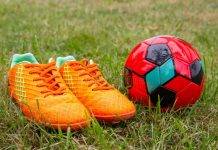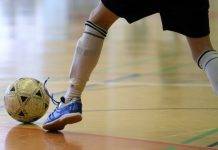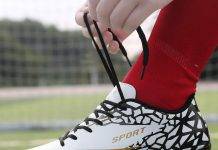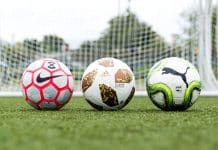Football cleats and soccer cleats – two essential pieces of footwear for athletes playing on different surfaces, both designed to enhance performance and provide optimal traction. But the burning question remains: which ones are better? As we delve into this debate and weigh the pros and cons of each, we aim to shed some light on the eternal rivalry between the studs and spikes, helping you make an informed decision for your own sporting endeavors.
This image is property of revupsports.com.
Fit and Comfort
Review contents
Ankle Support
When it comes to fit and comfort, ankle support plays a crucial role in keeping our feet stable and protected during intense movements on the field. Football cleats are specifically designed to provide excellent ankle support, often featuring high collars that wrap around the ankle bone. This added support helps to prevent ankle sprains and provides a secure fit, so we can confidently make rapid changes in direction without worrying about twisting our ankles.
Toe Box
The toe box is another important aspect of fit and comfort in football cleats. While both football and soccer cleats offer a snug fit around the toes, football cleats tend to have a slightly wider and more spacious toe box. This allows for more natural toe splaying and provides a more comfortable fit for players with wider feet or those looking for a bit more breathing space.
Sole Cushioning
Sole cushioning is crucial for reducing impact and providing added comfort during high-intensity movements on the field. Football cleats often prioritize cushioning in the forefront of the shoe to absorb the shock of quick stops and starts, jumps, and landings. The cushioning not only enhances comfort but also helps to reduce the risk of foot fatigue and injuries caused by repetitive motions.
Fit Customization
Fit customization is often an essential factor for ensuring optimal comfort in football cleats. Many football cleats feature technologies such as lacing systems, adjustable straps, and customizable insoles to allow players to personalize the fit according to their specific needs and preferences. This helps to achieve a snug fit that maximizes comfort and minimizes potential discomfort or blisters from friction.
Traction and Grip
Playing Surface
Both football and soccer cleats are designed to provide excellent traction and grip on various playing surfaces, such as grass, turf, or artificial turf. However, football cleats are typically engineered with longer and more prominent studs to offer superior traction on soft natural grass. Soccer cleats, on the other hand, typically have shorter studs or molded rubber patterns on the outsole, providing better stability and control on firm ground surfaces, including both natural and artificial turf.
Stud Configuration
Stud configuration plays a crucial role in determining the traction and grip of football cleats. Football cleats often feature a variety of stud configurations, such as a combination of conical and bladed studs, strategically placed in different patterns on the outsole. This allows for multi-directional traction and grip, enabling quick and explosive movements without losing stability. Soccer cleats, on the other hand, tend to have a more uniform stud pattern, prioritizing stability and control during continuous running and precise ball control.
Durability
Durability is a key consideration when choosing between football and soccer cleats. Football cleats are designed to withstand the rigors of rougher surfaces and aggressive gameplay, often featuring reinforced materials and added protective features. The construction of football cleats generally prioritizes durability to ensure they can withstand the demands of high-impact movements and potential contact with other players.
Traction on Different Surfaces
While both football and soccer cleats offer excellent traction on their respective playing surfaces, it’s essential to consider the versatility of the cleats for different field conditions. Football cleats are typically better suited for soft natural grass, providing optimal grip and traction in slippery conditions. Soccer cleats, on the other hand, tend to perform well on a wider range of surfaces, including firm ground and artificial turf, making them a more versatile choice.
Weight and Agility
Overall Weight
When it comes to weight and agility, lighter footwear often plays a significant role in enhancing performance. Both football cleats and soccer cleats have different weight characteristics. Football cleats tend to be slightly heavier, as they prioritize durability and support, which can impact speed and agility to some extent. Soccer cleats, on the other hand, are generally lighter, focusing on providing players with increased speed and maneuverability on the field.
Flexibility
Flexibility is another crucial factor affecting agility and performance. Football cleats often feature stiffer outsoles and uppers to provide stability and support during intense gameplay. While this reduces the overall flexibility of the cleats, it offers better resistance against lateral movements, preventing foot and ankle injuries. Soccer cleats, on the other hand, tend to be more flexible to enhance agility, allowing for quick changes of direction and precise ball control.
Agility
Agility is a key attribute in both football and soccer. Football cleats are designed with features that enhance lateral movement, allowing players to quickly change direction, evade opponents, and maintain stability. The sturdier construction of football cleats provides the necessary support for fast lateral movements, making them ideal for positions that require quick changes in direction, such as midfielders and defenders. Soccer cleats, on the other hand, prioritize lightweight and flexible designs to maximize agility, benefiting players who rely on fast footwork and quick bursts of speed.
Speed Enhancement
Speed is a crucial aspect of both football and soccer. While football cleats may be slightly bulkier due to added durability and support, they can still enhance speed through their traction and stability. The superior grip offered by football cleats allows players to push off the ground with more power, facilitating faster acceleration and straight-line running. Soccer cleats, being lightweight and flexible, are designed to maximize speed, as they enable players to move swiftly across the field, making them an ideal choice for speedy wingers and forwards.
Protection and Safety
Ankle Injuries
Ankle injuries are a common concern for players in both football and soccer. Football cleats offer excellent ankle support, providing stability and reducing the risk of twists and sprains during sudden changes in direction or contact with opponents. The higher ankle collar and sturdy construction of football cleats help limit ankle movements, minimizing the likelihood of injuries. Soccer cleats, although they may not provide the same level of ankle support, still offer some protection against minor ankle injuries while prioritizing lightweight design and mobility.
Toe Injuries
Toe injuries can occur in both football and soccer, particularly when players engage in physical contact or aggressive movements. The design of football cleats often includes reinforced toe boxes or protective features to safeguard against potential impacts. This can reduce the risk of toe injuries such as stubs, contusions, or fractures. Soccer cleats, while lacking specific toe protection, still provide a snug fit and lightweight design that minimizes the chances of toe injuries caused by improper footwear.
Midfoot Injuries
Midfoot injuries can be a concern for players in both football and soccer, especially when excessive strain is placed on the midfoot during jumps, kicks, or landings. The sturdy construction and materials used in football cleats help adequately support the midfoot, reducing the risk of injuries such as midfoot sprains or stress fractures. Soccer cleats, although typically not designed with specific midfoot support, still provide a secure fit and sufficient stability to offer a reasonable level of protection against midfoot injuries.
Heel Injuries
Heel injuries can occur due to repetitive impact and strain placed on the heel during intense gameplay. Football cleats often feature cushioning and reinforcement in the heel area to absorb shock and reduce the risk of heel injuries, such as bruises or plantar fasciitis. Soccer cleats, although generally not as heavily cushioned in the heel area, still provide adequate protection and stability to minimize the chances of heel-related injuries.
This image is property of ilovetowatchyouplay.com.
Material and Breathability
Synthetic Materials
Synthetic materials are commonly used in the construction of both football and soccer cleats. Synthetic upper materials provide durability, water-resistance, and shape retention, making them ideal for players who frequently play in wet or harsh conditions. These materials also tend to be more lightweight and offer improved breathability compared to natural materials, allowing for better airflow to keep our feet cool and dry during games.
Leather
Leather is another popular material used in the production of football and soccer cleats. Leather cleats offer excellent durability, comfort, and a snug fit that molds to the foot over time, enhancing overall performance. Leather also possesses natural breathability, allowing air to circulate and regulate foot temperature. However, leather cleats may require more maintenance and proper care to ensure they maintain their quality and performance over time.
Breathability
Breathability is a vital aspect of football and soccer cleats, as it helps to prevent excessive sweating and discomfort during prolonged periods of play. Many modern cleats, including both football and soccer varieties, incorporate mesh panels or perforations in the upper materials to enhance airflow and promote ventilation. This helps to dissipate heat and moisture, keeping our feet cool and dry, reducing the likelihood of blisters and fungal infections.
Moisture Wicking
Moisture wicking is a valuable feature in football and soccer cleats that helps to keep our feet dry and comfortable during intense gameplay. Many cleats utilize moisture-wicking technologies and materials that actively draw sweat away from the skin and towards the outer surface of the cleats, promoting quick evaporation. This ensures that our feet remain dry and fresh throughout the game, reducing the chances of discomfort and smelly feet.
Playing Position
Goalkeeper
As a goalkeeper, having the right cleats is essential to provide optimal performance and protection. The choice of cleats for goalkeepers often depends on personal preference and playing style. Goalkeepers may benefit from football cleats that offer excellent traction and stability, helping them to quickly react and make agile movements in goal. Additionally, cleats with increased padding and protection may be preferable for goalkeepers who frequently dive or come into contact with the ground.
Defender
Defenders require cleats that offer both stability and protection. Football cleats designed for defenders often prioritize features such as ankle support and durable construction to withstand physical challenges and potential contact with opponents. The traction and grip of the cleats are also crucial for defenders to maintain stability during tackles and changes in direction. Soccer cleats with additional protective features may also be suitable for defenders, who need to balance agility with robustness.
Midfielder
Midfielders engage in a combination of defensive and offensive play, requiring versatile cleats that offer a balance between agility, support, and ball control. Football cleats that provide excellent traction and stability can enhance a midfielder’s ability to change direction quickly and maintain balance during intense gameplay. Cleats with a responsive and cushioned insole can also support midfielders during long periods of running and provide comfort throughout the game.
Forward
Forwards rely on speed and agility to outpace defenders and score goals. Lightweight soccer cleats designed for forwards offer a balance of speed-enhancing features and ball control. Cleats with a snug fit and responsive outsole can help forwards accelerate quickly and make explosive movements off the mark. Additionally, cleats with superior grip and stud configuration enable forwards to maintain stability while cutting and pivoting, giving them an advantage in one-on-one situations.
This image is property of juventussandiego.com.
Playing Style
Aggressive Style
Players with an aggressive playing style require cleats that provide maximum support and durability. Football cleats designed for aggressive players offer robust construction, ankle support, and reinforced toe boxes to withstand physical contact and intense gameplay. These cleats prioritize stability and traction, providing the necessary grip to push off the ground forcefully during explosive movements and maintain balance during tackles and challenges.
Technical Style
Players with a technical playing style benefit from cleats that offer exceptional ball control and maneuverability. Lightweight soccer cleats with a low profile design and minimal padding are typically favored by technical players. These cleats provide a closer touch to the ball, allowing for greater precision and control during dribbling, passing, and shooting. The flexibility and responsiveness of the cleats also facilitate quick changes in direction and agile movements.
Balanced Style
Players with a balanced playing style require cleats that can adapt to a combination of offensive and defensive roles. Football cleats that offer a balance between stability, support, and agility are well-suited for players with a balanced style. These cleats provide sufficient ankle support, cushioning, and traction to accommodate both offensive and defensive movements effectively. Soccer cleats designed for all-around performance also offer a versatile option for players with a balanced playing style.
Physical Style
Players with a physical playing style need cleats that can withstand aggressive challenges and provide enhanced protection. Football cleats with a sturdy construction, reinforced materials, and added padding are ideal for players with a physical style. These cleats offer excellent traction, stability, and ankle support, allowing players to engage in physical battles and win duels without compromising their safety or performance.
Price Range
Entry-Level Options
Entry-level football and soccer cleats offer affordability without compromising basic performance features. These cleats typically utilize synthetic materials and standard stud configurations to provide traction and stability. While entry-level cleats may lack some advanced technologies and customizability found in higher-priced options, they still offer sufficient comfort and functionality for casual or beginner players who do not require specialized features.
Mid-Range Options
Mid-range football and soccer cleats strike a balance between performance and price. These cleats often incorporate advanced technologies, such as customizable fit systems or improved cushioning, to enhance comfort and performance. They may also feature enhanced durability and additional protective features to cater to the demands of competitive play. Mid-range cleats provide excellent value for players who seek higher performance without breaking the bank.
High-End Options
High-end football and soccer cleats represent the pinnacle of performance and innovation. These cleats often feature the latest technologies, such as carbon fiber plates, advanced stud configurations, or responsive cushioning systems, to maximize performance. High-end cleats prioritize superior fit customization, comfort, and durability, offering players the highest level of performance and protection available in the market. These cleats are typically favored by professional athletes or dedicated players who demand the best.
Value for Money
Determining the value for money in football and soccer cleats depends on individual preferences, playing style, and the importance placed on specific features. While high-end cleats may offer the most advanced technologies and performance-enhancing features, they may not necessarily be the best choice for every player. Players should consider their skill level, playing frequency, and position to identify the cleats that provide the right balance of comfort, performance, and durability, ensuring optimum value for money.
This image is property of soccernovo.com.
Brand and Design
Popular Football Cleat Brands
Several reputable brands specialize in producing high-quality football cleats that cater to the diverse needs of players. Brands such as Nike, Adidas, Puma, and Under Armour have gained popularity for their innovative designs, advanced technologies, and endorsements from professional athletes. These brands continually strive to push the boundaries of performance and offer a wide range of cleats to cater to different playing styles, positions, and budgets.
Popular Soccer Cleat Brands
Similar to football cleats, soccer cleats from renowned brands like Nike, Adidas, Puma, and Under Armour dominate the market. These brands invest heavily in research and development to create cutting-edge designs and technologies that enhance performance and comfort on the soccer field. Popular soccer cleat series, such as Nike Mercurial, Adidas Predator, and Puma Future, have become iconic symbols of performance and are trusted by professional players across the globe.
Design and Aesthetics
Design and aesthetics play a significant role in the appeal of football and soccer cleats. Cleats are available in an array of colors, patterns, and styles, allowing players to choose the cleats that match their personal preferences and team attire. Eye-catching designs can boost confidence and help players express their individuality on the field. However, while design is subjective, it’s essential to prioritize performance and functionality over aesthetics to ensure the cleats meet the specific demands of the game.
Brand Reputation
Brand reputation is an influential factor when selecting football and soccer cleats. Established brands with a strong reputation often signify reliability, quality, and extensive experience in producing footwear for athletes. These brands invest in research and development, ensuring their cleats are continually improved and aligned with the evolving needs of players. Reputable brands also tend to have a more extensive range of options, providing players with a wider selection of cleats to cater to their specific requirements.
Personal Preference
Individual Foot Characteristics
Considering personal foot characteristics is essential to ensure a proper fit and maximum comfort when selecting football or soccer cleats. Players with wider feet may prefer football cleats, as they generally provide a more spacious toe box and accommodate a broader foot shape. On the other hand, players with narrower feet may prefer soccer cleats, as they typically offer a snug and contoured fit that wraps closely around the foot. Understanding individual foot characteristics helps players find the cleats that match their unique foot shape and reduce the risk of discomfort or fit-related issues.
Previous Experience
Previous experience with different cleats can provide valuable insight when choosing between football and soccer cleats. If a player has been playing in a specific type of cleat and has found it to be comfortable and suitable for their style of play, sticking with that type may be the most practical choice. However, players should also be open to experimenting with different cleats, as advancements in technology and design may offer improved performance or features that suit their evolving needs.
Fit Testing
Fit testing is crucial to ensuring the proper fit of football or soccer cleats. Trying on cleats in-store or ordering them online with the option for returns allows players to assess the fit and comfort before committing to a purchase. It is essential to lace up the cleats properly and walk around, mimicking the movements that occur during gameplay, to evaluate the overall fit, support, and comfort. Conducting fit testing helps players identify any potential discomfort or fit issues and allows them to make an informed decision regarding the cleats that best suit their needs.
Trial and Error
Finding the perfect football or soccer cleats often involves a certain degree of trial and error. Due to the diverse range of options available, it may take some experimentation to find the cleats that tick all the boxes in terms of fit, comfort, performance, and protection. Players should be willing to try different cleats, since what works for one player may not work for another. Through trial and error, players can narrow down their preferences and ultimately find the cleats that enhance their performance and overall enjoyment of the game.
This image is property of www.soccercleats101.com.










































